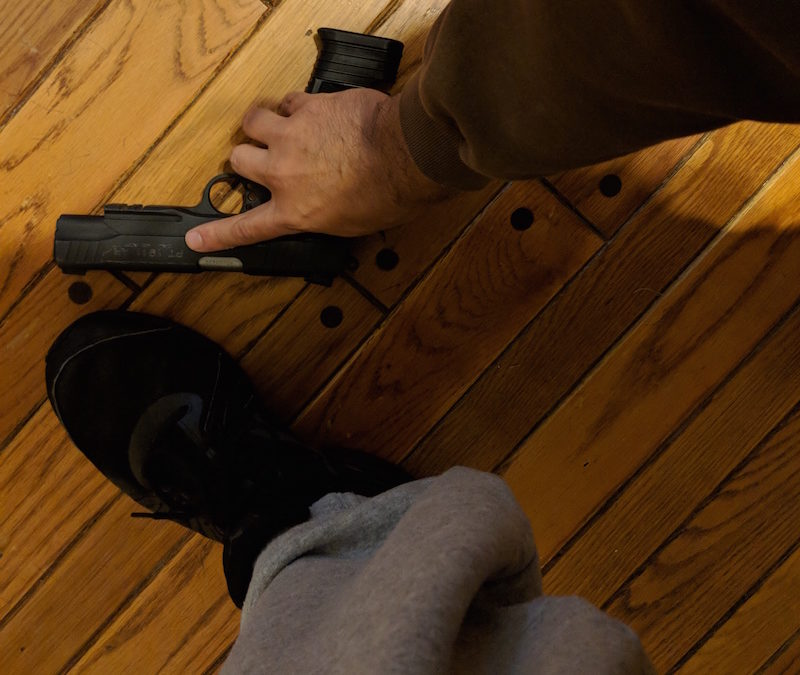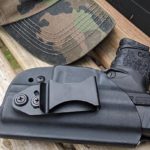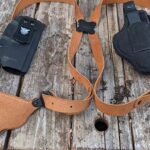Note: This article does not constitute legal advice, and is for informational purposes only. It is recommended that you conduct your own inquiries into the legality of any issue contained in this article.
“Oops, don’t mind me.” We’ve all had the unfortunate event where our concealed carry weapon finds a way out of our holster. This is particularly true of those with a new concealed carry permit, or when testing out a new form of carrying your weapon.
Usually, my weapon will not clear the holster entirely, because I can feel the gun shifting underneath my clothing. At that point, I can push the handle and ensure the weapon doesn’t clear to a point where the trigger is exposed. However, in the unlikely event that this does happen to you, should you try to catch a gun that falls out of your holster? The answer is that you should not attempt to catch a falling weapon. If you are carrying with a round in the chamber, and grab the pistol and squeeze the trigger, your firearm will discharge. You are better off letting the weapon fall to the ground and carefully collecting it.
It can be embarrassing for your concealed weapon to end up on the floor with a crowd of onlookers gawking at your pistol. However, this is a far better scenario than a trip down to the station because you put someone in the hospital (or worse, the morgue) trying to catch your gun.
Table of Contents
How Does A Weapon Fire
In order to understand why it’s a bad idea to try and catch a falling gun, we’ll need to understand the basics of how an automatic reloader (henceforth I will refer to it as an “automatic”) works. There are several important pieces responsible for making an automatic function. Each piece is outlined below, along with a brief explanation.
Cartridge – More commonly referred to as “the round” though it actually consists of, the projectile (bullet), the casing, the powder, and the primer.
Magazine – Contains additional cartridges, can be single or double stack.
Chamber – Where a bullet is housed, when ready to be struck by the firing pin.
Slide – Movement of this piece is responsible for the loading of the cartridge into the chamber. Works in conjunction with a spring.
Trigger – Squeeze this piece to release the hammer.
Hammer – Found on the rear of the pistol, responsible for initiating the firing pin.
Firing Pin – Strikes the primer, and ultimately responsible for the discharge of the projectile.
The Mechanics Of Firing An Automatic
Alright, now that we’ve established the important pieces, let’s move onto the mechanics of an automatic. When a magazine is loaded into a completely empty (cleared) weapon there is no round in the chamber. When the slide is pulled back, the hammer is cocked and a round is fed toward the chamber. Releasing the slide causes the spring to move the slide forward, completely loading the round. At this point, the round is chambered, and the weapon is ready to fire.
When you discharge your weapon, the hammer falls. The hammer forces the firing pin forward, which strikes the primer. Think of the primer like the flint in your lighter. It causes a spark inside the casing which ignites the powder, causing a mini explosion. The resulting reaction causes the projectile to exit the barrel and simultaneously causes the slide to move backward. Equal and opposite reactions are responsible for the transfer of energy into the slide.
When the slide moves back, the hammer is cocked, a new round is fed. Next, the slide moves forward, a new round is chambered, and you’re ready to fire again. Hence, the name auto reloading, for this type of pistol.
Why You Shouldn’t Try To Catch A Falling Gun
Now that you understand the basic principles of how a firearm works, let’s examine why it’s a bad idea to Willy Mays your falling firearm. The premise of these arguments is predicated on a round being in the chamber of your concealed weapon.
Barring any safeties on your weapon, when the pistol falls it is ready to shoot. Reaching out and grasping your pistol could unintentionally disable a safety. However, not all weapons are equipped with safety features. Regardless of either scenario, the biggest risk is that you will grab the pistol and squeeze the trigger. Remember, the trigger is the beginning of the chain reaction that results in your weapon discharging.
While the mechanics of a revolver are different than an automatic, the basic principles for expending a round are the same. The hammer is still responsible for causing the firing pin to strike the primer on the round. Therefore, attempting to catch a revolver is also dangerous.
Letting the weapon fall to the ground, as heart-breaking or embarrassing as it may be is the safest option. Some of you may be wondering if the weapon could discharge on impact with the ground. This is not outside the realm of possibilities, however, it is not likely. Because the firing pin is encased within the slide, the likelihood of it striking the primer is rare.
How To Avoid A Gun Falling Out
Prevention of this scenario starts with research. First, research your weapon and any known defects before purchasing. This will let you know if there is a pattern of accidental discharges for the model you are considering. Safety features are a bonus, though not a requirement as many firearms do not come with them.
Second, choose your accessories with care. I’ve found the best way to find quality products is to read reviews by others. Also, test holsters out to ensure they fit your needs. If you get a universal fit holster, put it through the wringer. Do everyday physical activities with your holster on, and an unloaded weapon to ensure your weapon won’t fall out. I’ve found the best method is getting a holster or carry method specifically designed for your model of weapon. At the very least, get a holster made for the size of your pistol (full-size, compact, sub-compact).
Ideally, the holster you choose will have some kind of retaining strap, or locking mechanism. Any feature like this will help prevent your firearm from falling out at the wrong time.
Securing Your Firearm Afterwards
In the unfortunate event that your weapon does leave its holster. Do not panic. Wait for the firearm to come to a complete rest before trying to pick it up. Haste is your worst enemy and increases the odds that things will end with an injury, or worse. Take the FBI agent for example who did a backflip, and then rushed to pick up his weapon.
Calmly pick up the weapon, and holster it. Take care to keep your finger off the trigger. I also highly recommend getting out of any populated area and assessing the condition of your weapon. I would clear the weapon first, then reload and re-chamber before continuing with your day.
If you’re wondering whether you’ll be treated like a criminal should your firearm fall out, I wouldn’t. While you may be asked to leave an establishment by the owner, accidents will happen. I suggest you exit anyway to inspect your gun before continuing your day.
Parting Shots
While the possibility exists that your firearm will discharge when it hits the ground, it’s safer than the alternative. Trying to catch a gun that falls out of your holster means you could cause the gun to discharge when it otherwise wouldn’t.
Personally, I’d rather not have powder residue on my hands when the police arrive. Also, bystanders may perceive the act as intentional. The accidental discharge caused by a falling firearm seems less difficult to prove. Regardless, should your weapon discharge, there can be very real consequences. I highly recommend getting a quality holster to help prevent this from ever happening to you. An ounce of prevention is worth more than a pound of cure.
What are your thoughts? Do you have a question I did not address? Leave me your thoughts in the comment section.










